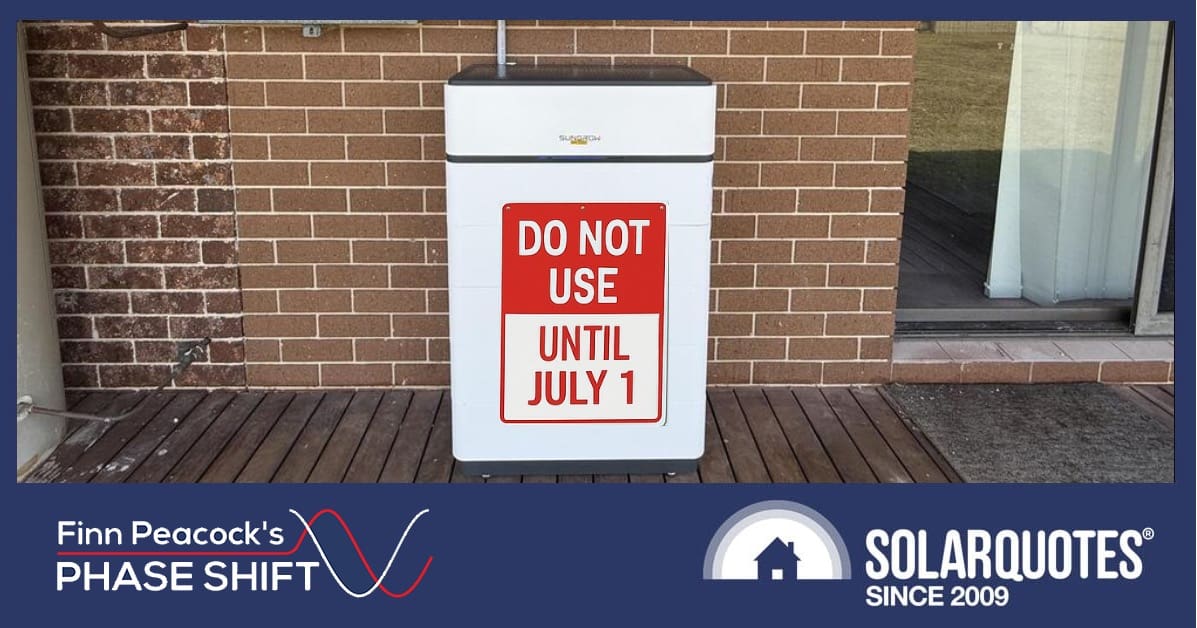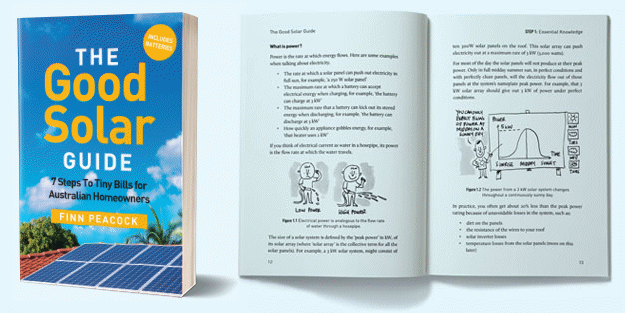
Batteries are still expensive, and for many solar owners they remain just out of reach. So a rebate of $3,700 off a 10 kWh battery, administered through the existing Small-scale Renewable Energy Scheme (SRES), is exactly what’s needed to get them over the line.
Using the SRES framework means the rollout can be fast, with minimal bureaucracy. It’s also retroactive — so if you install a battery between now and July 1, and Labor is re-elected, you’ll still be eligible for the rebate.
That retroactivity should soften the usual effect of everyone freezing their wallets for three months while they wait for a rebate to kick in.
Should.
In reality, most people will still wait. They don’t want to cashflow thousands of dollars for a rebate that isn’t locked in. And they definitely don’t want to risk missing out over some technicality in the paperwork. So while the intent is good, the market will likely stall anyway.
A Battery You Aren’t Allowed To Use
There was, however, one takeaway from an industry briefing that really made my jaw drop: batteries installed from now to July 1 will also be eligible (assuming Labor is returned to power), but cannot be switched on until July 1.
Sorry — what?
You can pay for a battery. You can get it installed. You can have it wired up to your switchboard. You can connect it to the grid. But you’re not allowed to switch it on?
That’s not just bureaucratic overreach. It’s actively stupid.
The entire point of this rebate is to help households save money and support the grid. So the faster batteries are installed and operating, the better. Why make people wait? What possible good is served by forcing energy storage systems to sit idle for three months?
It’s a classic example of process trumping reality. Some legal or political technicality, probably dreamed up in a Canberra meeting room, has ended up overriding basic common sense. If the paperwork’s not final, fine. But let people use the gear they’ve paid for.

Labor is promoting its rebate as a way to reduce energy bills — once owners are finally allowed to turn the batteries on, that is.
Over To You, Peter
And it’s not like the Coalition’s policy is any better. At the time of writing, Opposition Leader Peter Dutton hasn’t announced a battery rebate of his own, perhaps because he’s too busy with his imaginary nuclear plans. C’mon Peter, here’s a great opportunity to craft a better battery rebate than Albo’s with minimal effort: just photocopy Labor’s proposal, but Tippex out the ‘keep it switched off’ clause.
I won’t hold my breath.
So we’re stuck with a policy that’s mostly great… except for the part where it tells you to install expensive, money-saving, grid-improving, emissions-reducing technology — and then not use it for 3 months.
Honestly, why stop there? Maybe we should increase the heat pump rebate but ban hot showers until spring.
Let’s hope common sense flicks the switch back on before July 1.
For more on Labor’s proposed battery rebate, read over what we know about the scheme so far, and what kind of potential savings are on offer.

 RSS - Posts
RSS - Posts



We’re looking at getting a battery, but are holding off – well, we have one booked, but have stipulated a requirement that the installer has noted in the contract.
The WA rebate only provides for 20,000 batteries. There appears to have be a large interest, so we have no idea if we’ll ‘make the cut’, which is our stipulation for the battery. No rebate = no battery.
We’re looking at a 13.3kW (Alpha Smile) battery for $9000 installed. (not spending a lot as this is out first battery and not sure if it’s for us). I’m curious how the rebates work. Does the installer submit the p/work and they receive the $ or do we pay full amount and then claim the rebates afterwards? The latter option concerns me, as if we install the battery, apply for the WA rebate and then told no spots left…
Then the Labour rebate was announced, but only if the are re-elected.
For the battery we’re looking at, $5000 (state) + $4921 (federal), we’d be paid $921 to install the battery??
A bit like when I put solar on and everything is working fine but had to wait a month until the inspector came and ok’d it and switch it on !!
Hello Finn. What is the situation for those who already previously installed a battery? Will they be eligible for a subsidy if they wish to add more battery storage capacity to their home system? Regards. Francesco
Additional capacity will be eligible as far as we know
Agree the policy is nonsensical as it stands. Something nobody has mentioned is the question of warranty. Who will want to purchase and install a battery, if the warranty clock starts to tick while the battery is sitting unused?
Question – I installed one in NSW in January will I be eligible retroactively? Also if I upgrade with more 8kwh modules on a sigenergy will I be eligible?
I’m having an extra couple of modules added to my battery next week. I’m not dicking about waiting for a discount, i dont even know if those extra modules can be “switched off” until July 1 and the rest of the battery still be useable anyway – i doubt it, That’s not exactly a feature in demand until this point is it?.
Typical political bulldust really isn’t it?
I’m in this exact position – 3x Suntank batteries due for installation this coming Tuesday, along with panels and the inverter. I don’t want to delay the install so I’m still getting it done but what a joke that the battery is going to sit there idle for months and Labor might not win anyway. I cannot think of a single reason for this aspect of the policy, absolute nonsense
I’m usually on board with your views but you’re gilding the lily a fair bit.
We won’t know the election result until the first week of. May. If a battery was ordered at that time, it would probably take a month to be installed.
That would leave a maximum of 3 weeks (not months) with it sitting idle. Not ideal, but not what you stated.
Hi. I have a Sungrow SBR battery installed already. What do you think the chance is of getting any additional expansion modules covered under the SRES scheme? Thanks
In case there ever is another rebate for Qld batteries, a question arises:
One year old 13.5 panels, 10kW Sungrow inverter…
Options:
1. Add batteries plus inverter and AC couple or
2. Replace inverter with Hybrid type and batteries and D couple.
I recall some concerns about limited throughput on hybrid inverter or all current going via the inverter so even no grid power at all in case of inverter failure.
Be interested in expert comments
Marty, My brother is on-grid, connected as in Victron’s “Grid parallel topology with MPPT solar charge controller” in their Datasheet_MultiPlus-II-inverter-charger-EN.pdf i.e.
Grid -> Inverter_In :: Inverter_Out -> Loads <- PV inverters (ABB in his case)
| |
25 kWh Batteries PV panels
|
MPPTs
|
PV panels
One 5 kVA inverter passes 50 A from the grid. He has two, so 23 kW limit.
Need more grid? Add more in parallel.
He went from 14 to 25 kWh of batteries by just connecting them to the busbar, after matching SoC. It's been running for 5 years now.
Need more solar? Add MPPTs & DC couple. Check isolator & DC wiring capacity. (The Victrons can't gridform over 1:1, so AC expansion is no go.)
I use that topology off-grid. Works fine.
We have a recent 25kw sungrow hybrid inverter installed about a year ago, it comes with a changeover/bypass switch so in the event you do have an inverter issue you flick the switch and you’re back in regular grid power. Search for broad or changeover on here and you’ll likely find the article.
Hi,
I’ve just had my new system installed, which includes a 16 kWh battery. The installer switched on the battery for a few minutes ( with my permission and agreement) to check that the battery was functioning correctly. After only a few minutes the battery was switched off. My question is, have I jeopardised my rebate?